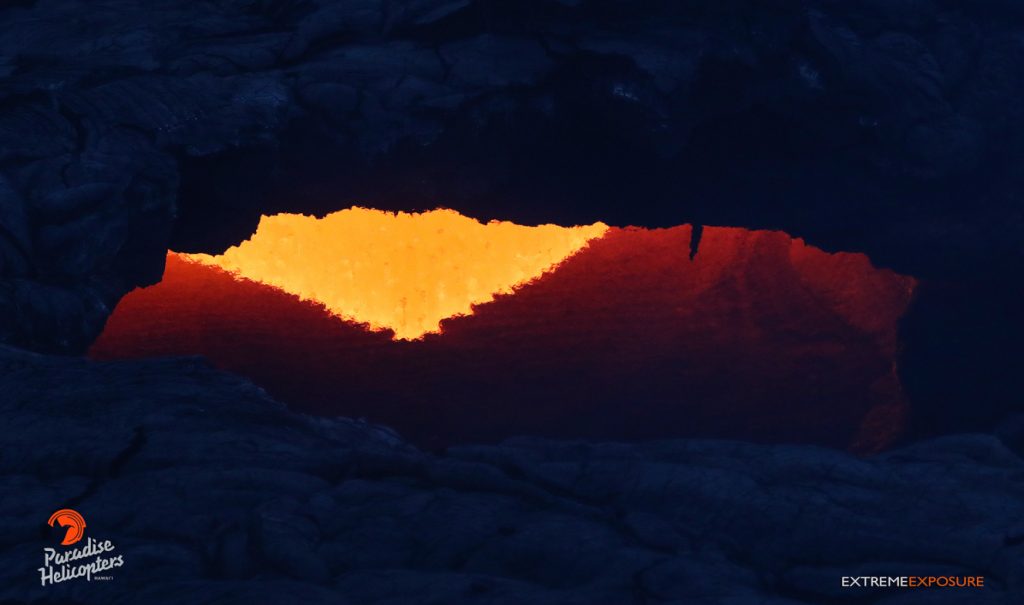Volcano Flyover Reveals Lava Plume & Skylight
Paradise Helicopters crew with Tropical Visions Video’s photographer/videographer Mick Kalber conducted a volcano flyover on Thursday, Oct. 6, 2016.
Pele’s plume from the Pu’u ‘O’o vent stretched southeast over the Pali on Thursday morning, as the 61g flow continues unabated.
The vent’s lava lake was largely obscured this morning, said Kalber.
“About a mile-and-a-half down the path to the ocean, we discovered a large gaping skylight,” Kalber said. “The break in the tube allowed us to see lava coursing by, feeding the ocean entry some six miles from the vent. Like moths to a flame, another similar skylight just a quarter mile or so above the ocean entry is attracting numerous visitors. The hot molten rock snakes beneath and into the Pacific Ocean. The eastern ocean entry is extremely robust now… the western one has stalled out recently, part of its bench having collapsed earlier this week. Pele continues to form new black sand beaches along the coast near her ocean entries. The hot lava’s interaction with the cold seawater shattering the flow into bits that are then tumbled into submission. It’s truly a sight to behold! Bruce Omori, Special Guest, Jeff Jung and I were back with Paradise Helicopters’ superb pilot, Robert Mitchell. Mahalo, Rob… you da man!!!

A large skylight about a mile and a half downslope of Pu‘u ‘O‘o allowed a peek at the river of lava feeding flow 61G. Tropical Visions Video photo.
“Like moths to a flame, another similar skylight just a quarter mile or so above the ocean entry is attracting numerous visitors,” Kalber continued. “The hot molten rock snakes beneath and into the Pacific Ocean. The eastern ocean entry is extremely robust now… the western one has stalled out recently, part of its bench having collapsed earlier this week. Pele continues to form new black sand beaches along the coast near her ocean entries. The hot lava’s interaction with the cold seawater shattering the flow into bits that are then tumbled into submission. It’s truly a sight to behold! Bruce Omori, Special Guest, Jeff Jung and I were back with Paradise Helicopters’ superb pilot, Robert Mitchell. Mahalo, Rob… you da man!!!
Kalber reported that the eastern ocean entry is extremely robust but the western entry has stalled out recently and part of its bench collapsed earlier in the week.
“Volcano Goddess Pele continues to form new black sand beaches along the coast near her ocean entries,” said Kalber. “The hot lava’s interaction with the cold seawater shatters the flow into bits that are then tumbled into submission. It’s truly a sight to behold!”
USGS Volcano Observatory Cautions Visitors
As a strong caution to visitors viewing the 61g flow ocean entry, there are additional significant hazards besides walking on uneven surfaces and around unstable, extremely steep sea cliffs.
Venturing too close to an ocean entry exposes you to flying debris created by the explosive interaction between lava and water.
Also, the new land created is unstable because it is built on unconsolidated lava fragments and sand. This loose material can easily be eroded away by surf, causing the new land to become unsupported and slide into the sea.
In several instances, such collapses, once started, have also incorporated parts of the older sea cliff.
Finally, the interaction of lava with the ocean creates a corrosive seawater plume laden with hydrochloric acid and fine volcanic particles that can irritate the skin, eyes, and lungs.
USGS Hawaiian Volcano Observatory Update: Monday, Oct. 10
Activity Summary: Kīlauea Volcano continues to erupt at its summit and at the Puʻu ʻŌʻō vent on its East Rift Zone. Inflationary tilt at the summit continues this morning. The lava lake surface was 69 feet below the floor of Halemaʻumaʻu Crater as of Sunday late afternoon. The 61g lava flow continues to flow into the sea at Kamokuna. The flow poses no threat to nearby communities.
Summit Observations: Summit tiltmeters continued to record inflationary tilt over the past 24 hours. The lava lake surface, as of Sunday late afternoon was measured at 69 feet below the rim of the Overlook Vent; the lake level continued to rise overnight. Webcam views of the lava lake can be found online.
Summit Seismicity: Seimicity has not changed in the past day, and volcanic tremor amplitudes continued to fluctuate in association with lava lake spattering. Average daily summit sulfur dioxide emission rates ranged from 1,100 to 9,100 metric tons/day over the past week. GPS and InSAR data have recorded a long-term inflationary trend of the summit magma reservoir complex since 2010.
Puʻu ʻŌʻō Observations: No significant changes are visible on webcam images, with persistent glow continuing at long-term sources within the crater. A tiltmeter on the north flank of Puʻu ʻŌʻō recorded a slight inflationary trend during the past day. The sulfur dioxide emission rate from all East Rift Zone vents was about 310 metric tons/day when last measured on Sept. 26.
Lava Flow Observations: The 61g lava flow, extending southeast from Puʻu ʻŌʻō on Kīlauea’s south flank continues to supply lava to the ocean at Kamokuna. No active breakouts were visible on the coastal plain via satellite imagery as of Saturday.















